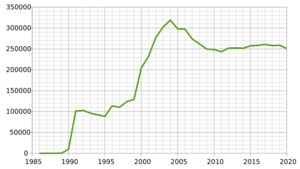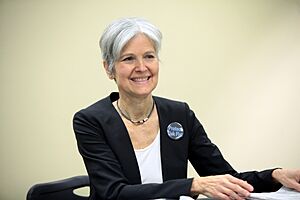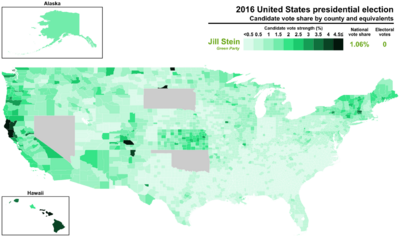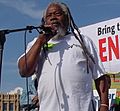Green Party of the United States facts for kids
Quick facts for kids
Green Party of the United States
|
|
|---|---|
 |
|
| Co-chairs |
|
| Green National Committee | |
| Founders | Howie Hawkins John Rensenbrink |
| Split from | Greens/Green Party USA |
| Headquarters | Takoma Park, Maryland |
| Membership (2024) | |
| Ideology | Green politics Progressivism Eco-socialism Libertarian socialism |
| Political position | Left-wing |
| Colors | |
| Seats in the Senate |
0 / 100
|
| Seats in the House of Representatives |
0 / 435
|
| State governorships |
0 / 50
|
| Seats in state upper chambers |
0 / 1,972
|
| Seats in state lower chambers |
0 / 5,411
|
| Territorial governorships |
0 / 5
|
| Seats in territorial upper chambers |
0 / 97
|
| Seats in territorial lower chambers |
0 / 91
|
| Other elected officials | 163 (June 2025)[update] |
The Green Party of the United States (GPUS) is a group of state-level political parties that work together. A political party is a team of people who share similar ideas about how to run a country. The Green Party focuses on green politics, which means they care deeply about protecting the environment.
Besides the environment, the party also works for nonviolence, social justice (fairness for all people), and giving everyone a voice in decisions. It is the fourth-largest political party in the United States based on the number of registered voters.
The Green Party first became widely known during the 2000 United States presidential election. Their candidate, Ralph Nader, received 2.7% of the total votes. Some people believe this took votes away from other candidates and changed the election's outcome. This is often called the "spoiler effect."
Contents
History of the Green Party
How the Party Started
The Green Party movement in the U.S. began in 1985 with small, local groups called the Committees of Correspondence. By 1990, these groups joined together to form a more organized national party. They focused on teaching people about their ideas and running for local offices.
Over time, members had different ideas about the party's direction. Some wanted to focus on local community work, while others wanted to run in national elections, like for president. This led to a split, and in 2001, the Green Party of the United States (GPUS) was officially formed. It quickly became the main Green Party organization in the country.
Recent Events
In 2020, Howie Hawkins ran for president as the Green Party candidate.
On August 17, 2024, the Green Party chose Jill Stein and Butch Ware as its candidates for President and Vice President for the 2024 election.
What the Green Party Believes In
The Four Pillars
The Green Party's main ideas are based on what they call the Four Pillars:
- Ecological Wisdom: Living in a way that is smart for the planet and its resources.
- Social Justice: Making sure all people are treated fairly and have equal opportunities.
- Grassroots Democracy: Giving ordinary people the power to make decisions in their communities.
- Nonviolence: Solving problems peacefully, without war or fighting.
Ten Key Values
The party also has Ten Key Values that expand on the Four Pillars. These include ideas like decentralization (spreading out power instead of having it in one place), feminism (equality for all genders), and respecting all cultures.
A major rule for the Green Party is that it does not take money from large corporations. They believe that big companies have too much influence on the government and want to keep politics focused on people.
Eco-Socialism
The Green Party supports an economic system called eco-socialism. This idea combines protecting the environment with creating a fairer society. It is different from both capitalism, where companies have a lot of power, and state socialism, where the government controls everything.
Under this system, many businesses would be owned and run by the workers themselves (cooperatives) or by the public. Things like healthcare, education, and public transportation would be free for everyone.
The Party's Stance on Important Issues
Healthcare
The Green Party wants a single-payer healthcare system. This means the government would provide health insurance for all citizens, paid for by taxes. They also believe that important health procedures should be available to everyone who needs them.
Education
The party supports making public colleges and trade schools free for students. They also want to cancel all existing student loan debt. They believe that education should be a public service, not a business.
Green New Deal
The Green Party created a plan called the Green New Deal. This plan aims to switch the U.S. to 100% clean, renewable energy like solar and wind power by 2030. The plan also includes creating jobs, providing free college, and offering healthcare for all.
Justice System
The party wants to make big changes to the criminal justice system. They support ending the death penalty and banning prisons that are run by private companies for profit.
Equal Rights
The Green Party strongly supports equal rights for all people. They advocate for LGBT+ rights, including the right for same-sex couples to marry. They also believe in making things right for the African American community for the historical injustice of slavery.
The party also supports youth rights. They believe young people should have a say in their education and that the voting age should be lowered to 16.
Who Supports the Green Party?
The Green Party has its strongest support in certain parts of the country. These areas include the Pacific Coast (like California and Oregon), the Upper Great Lakes region, and the Northeast.
As of June 2007, California had the most elected Green officials in the nation. Maine has the highest percentage of registered Green voters.
The party has also received strong support from Native American communities. For example, in the 2016 presidential election, Jill Stein received a high percentage of votes in counties with large Native American populations.
Green Party Officeholders
As of 2024, there were 143 elected officials in the U.S. who were members of the Green Party. These officials serve in local positions, such as on city councils or school boards. The party has not yet had a member elected to a federal office like the U.S. Congress.
Some Green Party members have been elected to state legislatures. For example, John Eder was elected to the Maine House of Representatives. Gayle McLaughlin was elected mayor of Richmond, California, a city with over 100,000 people.
No Green Party candidate has been elected to the U.S. Congress. However, some candidates have received a significant number of votes. In 2016, Mark Salazar received over 31% of the vote in his race for Congress in Arizona.
Presidential Election Results
The Green Party has nominated a candidate for president in every election since 1996. While they have never won, their candidates have brought attention to the party's key issues.
| Year | Presidential Candidate | Popular Votes | Percentage |
|---|---|---|---|
| 1996 | Ralph Nader | 684,902 | 0.7% |
| 2000 | Ralph Nader | 2,882,897 | 2.7% |
| 2004 | David Cobb | 119,859 | 0.1% |
| 2008 | Cynthia McKinney | 161,797 | 0.1% |
| 2012 | Jill Stein | 469,627 | 0.4% |
| 2016 | Jill Stein | 1,457,218 | 1.1% |
| 2020 | Howie Hawkins | 407,068 | 0.3% |
| 2024 | Jill Stein | 868,963 | 0.6% |
Images for kids
-
Malik Rahim, a former activist, ran for Congress in 2008 with the Green Party.
See also
 In Spanish: Partido Verde de los Estados Unidos para niños
In Spanish: Partido Verde de los Estados Unidos para niños
- List of political parties in the United States
- Third party (U.S. politics)






